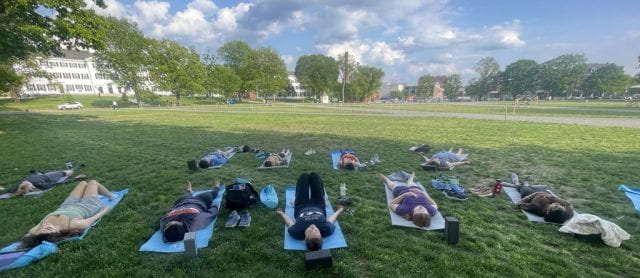Written by Michael Burns Jr ’26
Welcome back to the Summer of Reflection with the Student Wellness Center! If you’re joining us for the first time, get ready to embark on a journey of self-discovery and exploration as we dive into the different aspects that make up who you are. Just like the earth takes root, thrives, and provides nourishment, it’s time for us to reflect on the areas of our lives that contribute to vitality, balance, and joy. This week, we’re shining the spotlight on Physical Wellbeing, because taking care of our bodies is crucial for our minds and overall well-being.
Aspects of Physical Wellbeing include being active in a balanced way, getting enough sleep, and nourishing your body. For today’s purposes, we are honing in on the specific aspect of physical activity.
When we engage in physical activity* we cultivate the capacity to tap into the energy that fuels our mind, body, and spirit, aligning them in perfect harmony. It’s not just about toning up or training for a marathon; it’s also a natural mood booster and stress reliever. Activities that get our hearts pumping and our bodies moving release endorphins, those wonderful feel-good chemicals that leave us with a sense of euphoria and satisfaction.
A recent study conducted from CDC data analyzing responses from 1.2 million adults found that regular exercise reduced the number of poor mental health days a month by more than 40 percent! Reading this study further reaffirmed that exercise can have the amazing ability to change the way the brain functions, leading to a decrease in depression and anxiety in many individuals.
We know that engaging in physical activity may come more naturally for some*, while for others, it’s a big task and can feel like one more thing to add to the to-do list. If you tend to fall into the latter category and would like to bring greater intention to this aspect of physical wellbeing, here are some ways to help you get and STAY moving:
- Do one small thing differently – When we want to bring a change into our lives, we often go too big, too soon. We aim for something that might not be realistic nor sustainable, and before we know it, we feel like we have failed and give up. Instead of vowing to hit the gym everyday, start with something you feel completely confident in that you can stick with. Maybe it’s taking a longer route to class, taking the steps instead of the elevator, or having a dance party in your dorm room with friends. When we commit to taking small, doable steps towards the change we want, we build our confidence and enthusiasm for the next small step.
- Do something you like – It’s much easier to stick with something you enjoy doing rather than something that feels like complete drudgery! When it comes to creating a sustainable movement regimen, consider what types of movement-based activities bring you joy. Maybe it’s going for a walk, ride, or a roll along the scenic paths of the Upper Valley, or joining a dance group like RAAZ, taking a swim down at the river, or practicing yoga with the Wellness Center outside! These activities not only promote mental clarity, reduce anxiety and depression, but also enhance our emotional well-being.
- Try out a mind-body practice – Engaging in physical activity can help you access a beautiful synergy between the mind and body. It’s a sacred space where we become more attuned to our bodies, honoring their strength, flexibility, and resilience. Through mindful movement practices like yoga or qigong, we cultivate a deeper connection with ourselves, fostering self-awareness and promoting a sense of inner peace. This mind-body connection becomes a gateway to holistic well-being, allowing us to tap into our inner wisdom and nourish our souls.
*We want to take a moment and recognize that there are folks among us that struggle with disordered relationships with exercise and movement. For those of us who find it challenging to find balance with exercise and movement, nourishing your Physical Root may look very different from what we offered above. Instead of thinking about how to get MORE movement in, we invite you to consider the following instead:
- Consider what would be nourishing for you physically – we often think doing more is always better, but if you tend to be the kind of person who pushes yourself to the limit, doing less is actually what you may need more to feel at your best.
- Talk to a trained counselor/listener – if you are feeling stuck in a harmful and unhealthy pattern with exercise/movement, it can be helpful to talk to someone who can help you make a plan towards a healthier relationship with your body. Folks at the Counseling Center can be a great start, or schedule a Wellness Check In for a non-judgmental space to talk through your options.
In a busy world filled with demands, physical activity can act as a sanctuary of self-care for some, allowing the space to prioritize ourselves and nurture our bodies. These moments can help to recharge our energy, restore balance, and remind us of the importance of self-love. Engaging in a moderate level of physical activities builds resilience, confidence, and self-belief as we challenge ourselves, overcome obstacles, and discover our inner strength. It serves as a catalyst for personal growth that translates into all aspects of our lives. Additionally, physical activity fosters a sense of community and social connection, bringing like-minded individuals together and providing a shared sense of purpose. By embracing the transformative power of movement, we create a balanced and vibrant life that nurtures our overall well-being.
So go out there, ignite your passion, and let physical activity propel you towards a life of boundless joy and well-being. You’ve got this!
Wishing you wellness,
The SWC Team




